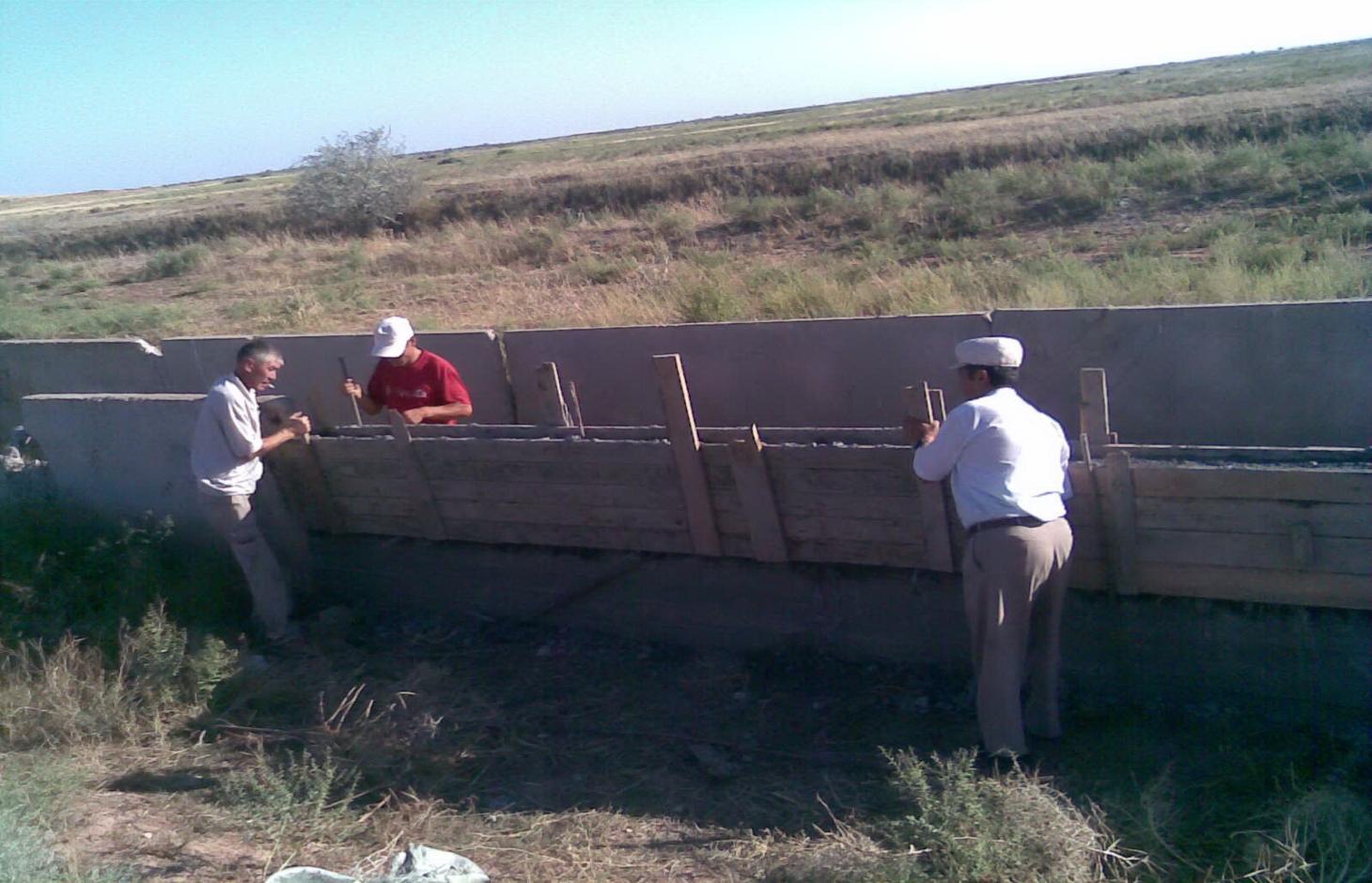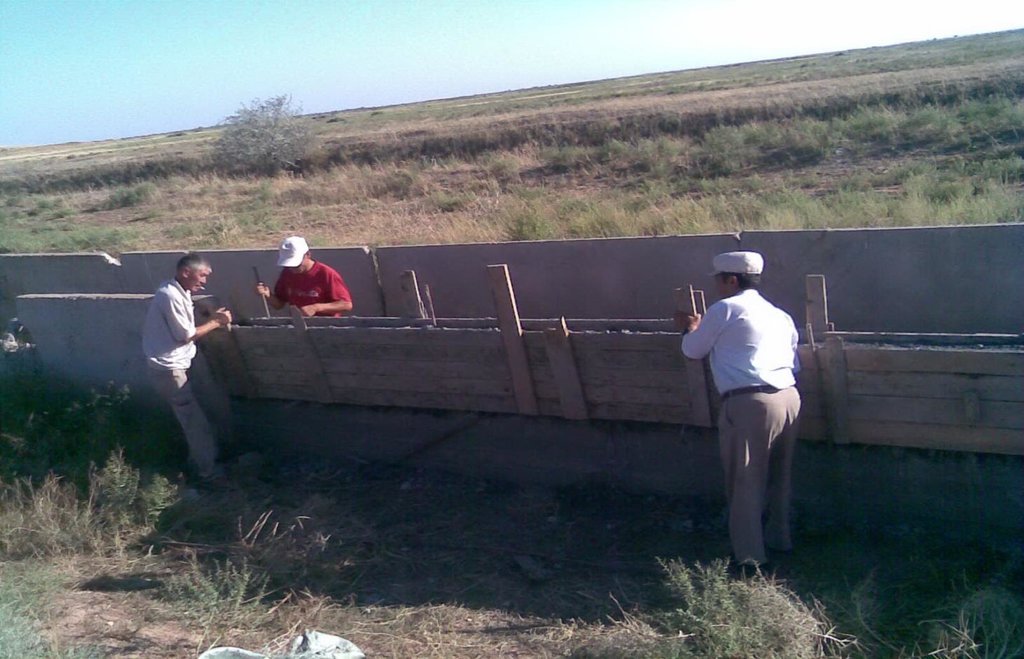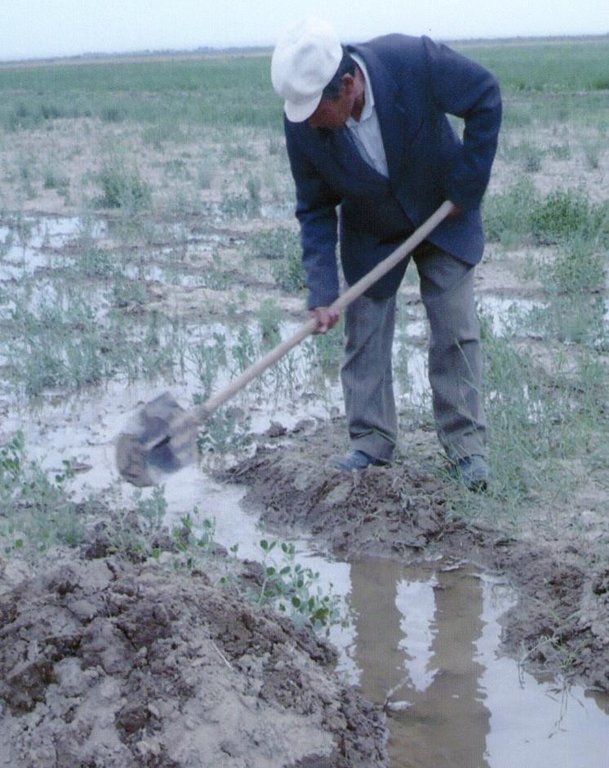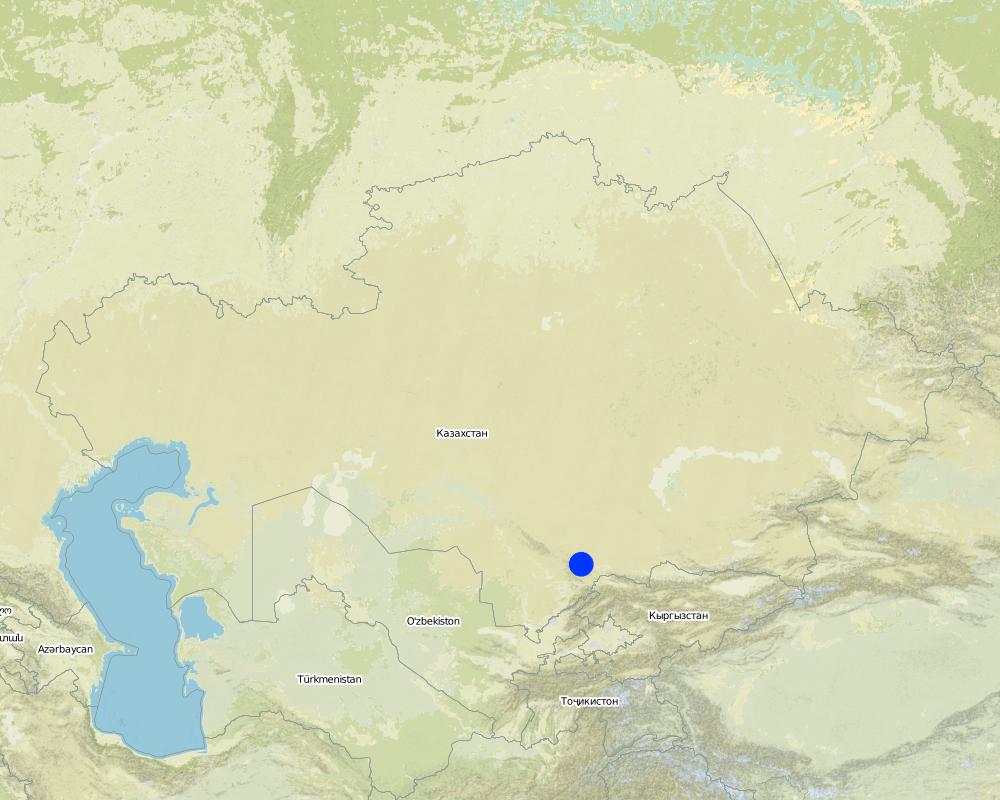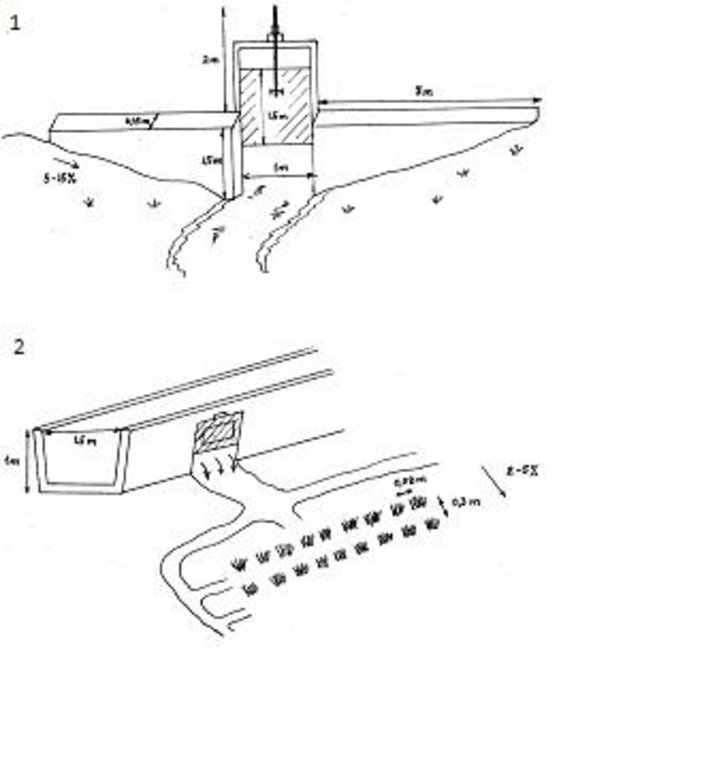Осеннее и ранневесеннее орошение как механизм для улучшения пастбищ в условиях изменения климата в Южном Казахстане (ИСЦАУЗР) [Kazakhstan]
- Creation:
- Update:
- Compiler: Azhar Yeszhanova
- Editor: –
- Reviewer: David Streiff
Инициатива Стран Центральной Азии по Управлению Земельными Ресурсами (CACILM/ИСЦАУЗР)
technologies_1121 - Kazakhstan
- Full summary as PDF
- Full summary as PDF for print
- Full summary in the browser
- Full summary (unformatted)
- Осеннее и ранневесеннее орошение как механизм для улучшения пастбищ в условиях изменения климата в Южном Казахстане (ИСЦАУЗР): Mei 26, 2017 (inactive)
- Осеннее и ранневесеннее орошение как механизм для улучшения пастбищ в условиях изменения климата в Южном Казахстане (ИСЦАУЗР): Aug. 6, 2017 (inactive)
- Осеннее и ранневесеннее орошение как механизм для улучшения пастбищ в условиях изменения климата в Южном Казахстане (ИСЦАУЗР): April 18, 2019 (public)
View sections
Expand all Collapse all1. General information
1.2 Contact details of resource persons and institutions involved in the assessment and documentation of the Technology
SLM specialist:
SLM specialist:
SLM specialist:
Kazakhstan
Name of project which facilitated the documentation/ evaluation of the Technology (if relevant)
Central Asian Countries Initiative for Land Management (CACILM I)Name of the institution(s) which facilitated the documentation/ evaluation of the Technology (if relevant)
Kazakh Research Institute for Soil Science and Agr (Kazakh Research Institute for Soil Science and Agr) - Kazakhstan1.3 Conditions regarding the use of data documented through WOCAT
When were the data compiled (in the field)?
17/09/2011
The compiler and key resource person(s) accept the conditions regarding the use of data documented through WOCAT:
Ja
2. Description of the SLM Technology
2.1 Short description of the Technology
Definition of the Technology:
Раннее орошение полей и пастбищ с целью сохранения влаги в почве для сухого сезона в Южном Казахстане.
2.2 Detailed description of the Technology
Description:
Технология реализована в селе Саду Шакиров (Таласский район, Джамбыльская область). В советское время в селе было 2105 га орошаемых пахотных земель и 66408 га орошаемых сенокосов. Вода для орошения подавалась из реки Талас по каналу «Шаруашлык» длиной 12 км. Деревня расположена в конце канала. Падение уровня воды в реке Талас в последние годы и чрезмерный забор оросительной воды пользователями выше по течению привели к резкому падению уровня воды в канале, и, как следствие, исчезновению орошаемого земледелия и деградации орошаемых земель в селе. Орошаемые пахотные земли были заброшены и использовались для круглогодичного выпаса скота. Эксплуатация канала прекратилась, и он пришел в негодность.
Ситуация усугубилась воздействием от изменения климата в регионе (снижение количества ранне-весенних, летних и зимних осадков, увеличение среднегодовой температуры, весенние и осенние заморозки и засухи летом). Сокращение количества и качества кормовых культур негативно сказалось на животноводстве и благосостоянии местного населения.
Проблема была решена общественным объединением «Когал деревни Саду Шакиров». Для искусственного накапливания влаги в почве в допосевной период посредством осенне-зимних влагозарядковых поливов, когда большинство водопользователей выше по течению не используют оросительную воду, было восстановлено 12км канала и 5 шлюзов для подачи воды. Влагозарядковые поливы улучшают рост травы на пастбищах. Они создают в почве (1,5-2 м) запас воды, которые сх культуры смогут использовать следующей весной или в начале лета. Тем самым сокращается число вегетационных поливов и отодвигаются сроки их проведения.
В первый год было увлажнено 90 га залежных земель. Местное сообщество использовало часть их для выращивания кормовых культур на зимние корма, чтобы обеспечить устойчивость животноводства (весной 60 га было засеяно люцерной), а оставшаяся площадь использовалась как естественные сенокосы. В результате, урожайность увеличилась с 3.5 до 5 ц/га. (в рамках ИСЦАУЗР)
Purpose of the Technology: Цель технологии состоит в сокращении процессов деградации земель и опустынивания через накопление влаги в корнеобразующем слое почвы в осенний и ранневесенний период
Establishment / maintenance activities and inputs: Мероприятия и вклады на введение / содержание:
1) Реконструкция 12 км канала, 5 шлюзов и оросительной системы на полях (нарезка поливочных борозд).
2) Создание сеяных пастбищ с посевом кормовых культур: подготовка почвы и посев люцерны, согласование норм полива. Полевые тренинги для жителей села по технологии.
Natural / human environment: Деревня расположена на пустынной равнине в предгорьях Южного Казахстана, в зоне внутреннего стока. Средний максимум температур в июле +45С, средний минимум температур в январе -41С, среднее количество осадков - 300 мм/год. Количество дней с пыльными бурями составляет 5-10 дней в год. Пески закрепленные и полузакрепленные занимают до 60% территории.
2.3 Photos of the Technology
2.5 Country/ region/ locations where the Technology has been applied and which are covered by this assessment
Country:
Kazakhstan
Region/ State/ Province:
Республика Казахстан
Further specification of location:
Жамбылская область, Таласский район
Map
×2.6 Date of implementation
If precise year is not known, indicate approximate date:
- less than 10 years ago (recently)
2.7 Introduction of the Technology
Specify how the Technology was introduced:
- through projects/ external interventions
Comments (type of project, etc.):
Метод осеннего и зимнего полива применялся в аридных зонах для полива виноградников. На описываемой территории с 2009 г. осуществлен проект в рамках Программы ПРООН по адаптации к изменению климата на уровне общин (АИКУО) в Казахстане.
3. Classification of the SLM Technology
3.1 Main purpose(s) of the Technology
- reduce, prevent, restore land degradation
- adapt to climate change/ extremes and its impacts
3.2 Current land use type(s) where the Technology is applied

Cropland
- Annual cropping
- Perennial (non-woody) cropping

Grazing land
Extensive grazing land:
- Semi-nomadism/ pastoralism
- Ranching
Comments:
Major land use problems (compiler’s opinion): климатические изменения в сторону засушливости, дефицит водных ресурсов
Major land use problems (land users’ perception): недостаток воды для полива пастбищ и полей, увеличение засушливости
Semi-nomadism / pastoralism: КРС, МРС, лошади, верблюды
Ranching: КРС, МРС, лошади, верблюды
Mixed: (eg agro-pastoralism, silvo-pastoralism): После сбора урожая кукурузы, люцерны осенью выпасается скот
Future (final) land use (after implementation of SLM Technology): Grazing land: Gi: Intensive grazing/ fodder production
If land use has changed due to the implementation of the Technology, indicate land use before implementation of the Technology:
Grazing land: Ge: Extensive grazing land
3.3 Further information about land use
Water supply for the land on which the Technology is applied:
- mixed rainfed-irrigated
Comments:
Water supply: смешанное богарно-орошаемое, смешанное богарно-орошаемое
Number of growing seasons per year:
- 1
Specify:
Longest growing period in days: 140
Longest growing period from month to month: апрель-август
Livestock density (if relevant):
1-10 УГ/км2
3.4 SLM group to which the Technology belongs
- irrigation management (incl. water supply, drainage)
3.5 Spread of the Technology
Specify the spread of the Technology:
- evenly spread over an area
If the Technology is evenly spread over an area, indicate approximate area covered:
- 1-10 km2
Comments:
Total area covered by the SLM Technology is 5,6 m2.
Площадь обводняемых в результате применения технологии раннего полива пастбищ и сенокосов составляет около 500 га, сеяных кормовой культурой земель составляет 60 га, которые в будущем году планируется увеличить до 100 га
3.6 SLM measures comprising the Technology

vegetative measures
- V2: Grasses and perennial herbaceous plants

structural measures
- S4: Level ditches, pits

management measures
- M2: Change of management/ intensity level
- M4: Major change in timing of activities
Comments:
Main measures: vegetative measures, structural measures, management measures
Type of vegetative measures: урегулированный: -линейныи
3.7 Main types of land degradation addressed by the Technology

chemical soil deterioration
- Cn: fertility decline and reduced organic matter content (not caused by erosion)

biological degradation
- Bq: quantity/ biomass decline

water degradation
- Ha: aridification
- Hs: change in quantity of surface water
Comments:
Main type of degradation addressed: Бк (Bq): уменьшение количества / биомассы, Да (Ha): аридность, Ди (Hs): изменение количества поверхностной воды
Secondary types of degradation addressed: Ха (Cn): снижение плодородия почвы и органических веществ в почве (не вызванные эрозией)
Main causes of degradation: нарушение водного цикла (инфильтрация / поверхностные стоки) (сокращение поступления воды в оросительные каналы в поливной сезон)
Secondary causes of degradation: изменение температуры, изменение сезонных дождей, засуха (Число дней с атмосферной засухой достигает 140-150 дней в году), управление/ инстициональныи (нет четкой договоренности по попускам воды из Кыргызстана)
3.8 Prevention, reduction, or restoration of land degradation
Specify the goal of the Technology with regard to land degradation:
- reduce land degradation
Comments:
Main goals: mitigation / reduction of land degradation
4. Technical specifications, implementation activities, inputs, and costs
4.1 Technical drawing of the Technology
Author:
Есжанова Ажар, Казахстан, 050010, Алматы, ул.Кабанбай батыра-ул.Пушкина, 67/99, Институт географии, azhare@rambler.
4.2 Technical specifications/ explanations of technical drawing
1) Строение и параметры одного из восстановленных шлюзов для осеннего и ранневесеннего орошения сеяных пастбищ и орошаемых сенокосов;
2) Строение оросительного канала после реконструкции для полива посевов люцерны
Location: Казахстан. Таласский/Жамбылская
Date: 2011-12-21
Technical knowledge required for field staff / advisors: высокий (Для реконструкции оросительного канала и шлюза, а также создания сеяных пастбищ привлекались консультанты (гидротехники, мелиораторы и агрономы))
Technical knowledge required for land users: средний
Main technical functions: повышение / поддержание сохранения воды в почве, распространение воды, содействие росту видов и сортов растительности (качество, например поедаемые кормовые культуры)
Aligned: -along boundary
Vegetative material: К: многолетние культуры
Aligned: -linear
Vegetative material: К: многолетние культуры
Number of plants per (ha): 500000
Vertical interval between rows / strips / blocks (m): 0
Spacing between rows / strips / blocks (m): 0,30
Vertical interval within rows / strips / blocks (m): 0,02
Perennial crops species: люцерна
Slope (which determines the spacing indicated above): 2-5%
Gradient along the rows / strips: 2-5%
Waterway
Depth of ditches/pits/dams (m): 1
Width of ditches/pits/dams (m): 1.5
Length of ditches/pits/dams (m): 7000
Spillway
Depth of ditches/pits/dams (m): 3.5
Width of ditches/pits/dams (m): 0.45
Length of ditches/pits/dams (m): 15.5
Construction material (stone): Щебень
Construction material (other): Бетонные плиты, сливные трубы, металлические угольники, арматура, железные листы
Slope (which determines the spacing indicated above): 2-5%
Beneficial area: 560 гаm2
Dimensions of spillways: 1.5m
For water harvesting: the ratio between the area where the harvested water is applied and the total area from which water is collected is: 1:1 : 9410 (Общая площадь водосб
Change of land use practices / intensity level: Переход от экстенсивных деградированных пашен к интенсивным (сеяным и косимым) пастбищам и обводненным сенокосам
Major change in timing of activities: В виду прекращения традиционного орошаемого земледелия произошел переход на осенний и ранневесенний влагозарядковый полив для получения сеяных косимых пастбищ и обводненных сенокосов
4.3 General information regarding the calculation of inputs and costs
other/ national currency (specify):
тенге
Indicate exchange rate from USD to local currency (if relevant): 1 USD =:
147.0
Indicate average wage cost of hired labour per day:
9.30
4.4 Establishment activities
| Activity | Type of measure | Timing | |
|---|---|---|---|
| 1. | 1. Выбор места и метода сеяния пастбищ | Vegetative | март |
| 2. | 1.Реконструкция 12 км канала | Structural | март |
| 3. | 2. Ремонт пяти (5) специальных шлюзов для регулирования попусков воды | Structural | апрель |
| 4. | 3. Проведение поливочных борозд (5 км) | Structural | апрель |
4.5 Costs and inputs needed for establishment
| Specify input | Unit | Quantity | Costs per Unit | Total costs per input | % of costs borne by land users | |
|---|---|---|---|---|---|---|
| Labour | None | None | 5.0 | 33.4 | 167.0 | 100.0 |
| Labour | None | None | 80.0 | 300.0 | 24000.0 | |
| Labour | None | None | 4.0 | 759.5 | 3038.0 | |
| Labour | None | None | 2.0 | 735.0 | 1470.0 | 100.0 |
| Equipment | None | None | 9.3 | 2107.52688 | 19600.0 | |
| Equipment | None | None | 6.3 | 630.0 | 3969.0 | |
| Construction material | None | None | 1.0 | 1102.5 | 1102.5 | |
| Total costs for establishment of the Technology | 53346.5 | |||||
Comments:
Duration of establishment phase: 2 month(s)
4.6 Maintenance/ recurrent activities
| Activity | Type of measure | Timing/ frequency | |
|---|---|---|---|
| 1. | 2. Подготовка почвы (планировка, вспашка, боронование) | Vegetative | Апрель/1 раз в 5 лет |
| 2. | 3. Посев люцерны на заброшенной деградированной пашне | Vegetative | Апрель/1 раз в 5 лет |
| 3. | 3. Посев люцерны на заброшенной деградированной пашне | Vegetative | Апрель/1 раз в 5 лет |
| 4. | 1. Сенокос | Vegetative | Несколько раз в вегетационный период |
| 5. | 1. Сенокос | Management | Несколько раз в вегетационный период |
| 6. | 2. Подготовка почвы (планировка, вспашка, боронование) | Апрель/1 раз в 5 лет | |
| 7. | Согласование норм полива и его регулирования | апрель/1 раз в 5 лет | |
| 8. | Влагозарядковый полив | Сентябрь-ноябрь/ ежегодно |
4.7 Costs and inputs needed for maintenance/ recurrent activities (per year)
| Specify input | Unit | Quantity | Costs per Unit | Total costs per input | % of costs borne by land users | |
|---|---|---|---|---|---|---|
| Labour | None | None | 10.0 | 500.0 | 5000.0 | 100.0 |
| Labour | None | None | 10.0 | 40.83 | 408.3 | |
| Labour | None | None | 10.0 | 40.83 | 408.3 | |
| Equipment | None | None | 0.6 | 578.33333 | 347.0 | |
| Plant material | None | None | 20.0 | 91.85 | 1837.0 | 50.0 |
| Total costs for maintenance of the Technology | 8000.6 | |||||
Comments:
Machinery/ tools: Трактор (сеялка), Экскаватор, бульдозер, грузовой транспорт
Затраты восстановление 12 км оросительного канала и реконструкцию 5 шлюзов разбросаны на 60 га сеяных пастбищ,
4.8 Most important factors affecting the costs
Describe the most determinate factors affecting the costs:
На сумму материальных затрат большое влияние оказывают недостаток собственной сельскохозяйственной техники у местного сообщества, отдаленность от районного и областного центра, а также от производственных точек (стройматериалы, семена), что влияет на затраты на ГСМ, рабочие часы, аренду транспорта и т.д.
5. Natural and human environment
5.1 Climate
Annual rainfall
- < 250 mm
- 251-500 mm
- 501-750 mm
- 751-1,000 mm
- 1,001-1,500 mm
- 1,501-2,000 mm
- 2,001-3,000 mm
- 3,001-4,000 mm
- > 4,000 mm
Agro-climatic zone
- arid
Thermal climate class: temperate
5.2 Topography
Slopes on average:
- flat (0-2%)
- gentle (3-5%)
- moderate (6-10%)
- rolling (11-15%)
- hilly (16-30%)
- steep (31-60%)
- very steep (>60%)
Landforms:
- plateau/plains
- ridges
- mountain slopes
- hill slopes
- footslopes
- valley floors
Altitudinal zone:
- 0-100 m a.s.l.
- 101-500 m a.s.l.
- 501-1,000 m a.s.l.
- 1,001-1,500 m a.s.l.
- 1,501-2,000 m a.s.l.
- 2,001-2,500 m a.s.l.
- 2,501-3,000 m a.s.l.
- 3,001-4,000 m a.s.l.
- > 4,000 m a.s.l.
5.3 Soils
Soil depth on average:
- very shallow (0-20 cm)
- shallow (21-50 cm)
- moderately deep (51-80 cm)
- deep (81-120 cm)
- very deep (> 120 cm)
Soil texture (topsoil):
- medium (loamy, silty)
Topsoil organic matter:
- medium (1-3%)
5.4 Water availability and quality
Ground water table:
5-50 m
Availability of surface water:
poor/ none
Water quality (untreated):
for agricultural use only (irrigation)
Comments and further specifications on water quality and quantity:
Water quality (untreated): good drinking water, for agricultural use only (irrigation)
5.5 Biodiversity
Species diversity:
- low
5.6 Characteristics of land users applying the Technology
Market orientation of production system:
- subsistence (self-supply)
- mixed (subsistence/ commercial
Off-farm income:
- less than 10% of all income
Relative level of wealth:
- average
Individuals or groups:
- groups/ community
Level of mechanization:
- manual work
- mechanized/ motorized
Gender:
- women
- men
Indicate other relevant characteristics of the land users:
Land users applying the Technology are mainly common / average land users
Population density: < 10 persons/km2
Annual population growth: < 0.5%
8% of the land users are rich and own 50% of the land.
75% of the land users are average wealthy and own 45% of the land.
16% of the land users are poor and own 4% of the land.
1% of the land users are poor and own 1% of the land.
Off-farm income specification: Вне хозяйства чаще всего никакой деятельности не ведется, только иногда частный извоз при наличии автотранспорта
Market orientation of production system: subsistence (self-supply), subsistence (self-supply), mixed (subsistence/ commercial
5.7 Average area of land owned or leased by land users applying the Technology
- < 0.5 ha
- 0.5-1 ha
- 1-2 ha
- 2-5 ha
- 5-15 ha
- 15-50 ha
- 50-100 ha
- 100-500 ha
- 500-1,000 ha
- 1,000-10,000 ha
- > 10,000 ha
Is this considered small-, medium- or large-scale (referring to local context)?
- small-scale
5.8 Land ownership, land use rights, and water use rights
Land ownership:
- state
- individual, titled
Land use rights:
- leased
- individual
Water use rights:
- communal (organized)
- leased
Comments:
Аренда земли на 49 лет, за пользование водой в сезон орошения взимается арендная плата
5.9 Access to services and infrastructure
health:
- poor
- moderate
- good
education:
- poor
- moderate
- good
technical assistance:
- poor
- moderate
- good
employment (e.g. off-farm):
- poor
- moderate
- good
markets:
- poor
- moderate
- good
energy:
- poor
- moderate
- good
roads and transport:
- poor
- moderate
- good
drinking water and sanitation:
- poor
- moderate
- good
financial services:
- poor
- moderate
- good
6. Impacts and concluding statements
6.1 On-site impacts the Technology has shown
Socio-economic impacts
Production
crop production
Quantity before SLM:
21 тонна
Quantity after SLM:
30 т
fodder production
Quantity before SLM:
21 тонна
Quantity after SLM:
30 т
fodder quality
animal production
Quantity before SLM:
КРС – 320 кг живого веса
Quantity after SLM:
КРС – 400 кг живого веса
Water availability and quality
irrigation water availability
demand for irrigation water
Income and costs
expenses on agricultural inputs
Socio-cultural impacts
food security/ self-sufficiency
health situation
community institutions
SLM/ land degradation knowledge
conflict mitigation
situation of socially and economically disadvantaged groups
Ecological impacts
Water cycle/ runoff
water quantity
water quality
harvesting/ collection of water
Soil
soil moisture
soil cover
soil loss
nutrient cycling/ recharge
soil organic matter/ below ground C
Biodiversity: vegetation, animals
biomass/ above ground C
beneficial species
6.2 Off-site impacts the Technology has shown
water availability
6.3 Exposure and sensitivity of the Technology to gradual climate change and climate-related extremes/ disasters (as perceived by land users)
Gradual climate change
Gradual climate change
| Season | Type of climatic change/ extreme | How does the Technology cope with it? | |
|---|---|---|---|
| annual temperature | increase | well |
Climate-related extremes (disasters)
Meteorological disasters
| How does the Technology cope with it? | |
|---|---|
| local rainstorm | well |
| local windstorm | well |
Climatological disasters
| How does the Technology cope with it? | |
|---|---|
| drought | not well |
Hydrological disasters
| How does the Technology cope with it? | |
|---|---|
| general (river) flood | well |
Other climate-related consequences
Other climate-related consequences
| How does the Technology cope with it? | |
|---|---|
| reduced growing period | not well |
6.4 Cost-benefit analysis
How do the benefits compare with the establishment costs (from land users’ perspective)?
Short-term returns:
negative
Long-term returns:
positive
How do the benefits compare with the maintenance/ recurrent costs (from land users' perspective)?
Short-term returns:
very negative
Long-term returns:
positive
Comments:
Предполагается дальнейшее расширение площадей, увлажненных влагозарядковым поливом, уже в 2011-2012 гг. ожидается увеличение доходов более чем в 2-3 раза, поскольку урожай люцерны будет больше, чем в первый год посева.
6.5 Adoption of the Technology
- 10-50%
Of all those who have adopted the Technology, how many have did so spontaneously, i.e. without receiving any material incentives/ payments?
- 10-50%
Comments:
83% of land user families have adopted the Technology with external material support
24 land user families have adopted the Technology with external material support
17% of land user families have adopted the Technology without any external material support
4 land user families have adopted the Technology without any external material support
Comments on spontaneous adoption: Многие жители, желающие внедрить технологию влагозарядкового полива, сталкиваются с материальными трудностями, но ищут поддержки из разных источников, в том числе у инициаторов и реализаторов практики
There is a little trend towards spontaneous adoption of the Technology
Comments on adoption trend: Тенденцию роста принятия технологии нельзя назвать значительной, т.к. многие местные жители всё еще опасаются сокращения количества поступающей воды в р.Талас из-за большого забора воды потребителями, находящимися выше по течению
6.7 Strengths/ advantages/ opportunities of the Technology
| Strengths/ advantages/ opportunities in the land user’s view |
|---|
|
Сокращение деградации почв, пыльных бурь How can they be sustained / enhanced? Продолжить через 5-6 лет посев люцерны, а также расширить площадь посева |
|
Повышение плодородия почв How can they be sustained / enhanced? Продолжить работы |
|
Улучшение кормовой базы How can they be sustained / enhanced? Необходима материальная поддержка и совместные усилия, справедливое разделение труда и доходов |
|
Повышение уровня жизни How can they be sustained / enhanced? Продолжать и расширять применение технологии |
| Strengths/ advantages/ opportunities in the compiler’s or other key resource person’s view |
|---|
|
Сокращение деградации почв (ветровая и водная эрозия, потеря гумуса и т.д.) How can they be sustained / enhanced? Применение технологии в строгом соответствии с руководством и инструкциями |
|
Применение влагозарядковых поливов позволяет восстановить посевы люцерны, что в итоге значительно улучшает качество почвы How can they be sustained / enhanced? Продолжение практики посева люцерны, обогащающей почву азотом и другими питательными веществами можно продолжать как один из эффективнейших мер для данных природно-климатических условий путем расширения площадей посевов и улучшения качества почв |
|
Повышение адаптированности местного населения к изменениям климата How can they be sustained / enhanced? Необходимо повышать и в дальнейшем информированность населения, пропагандировать и демонстрировать все экологические, экономические и социальные выгоды от применения технологии |
|
Улучшение институциональных связей и единства местной общины How can they be sustained / enhanced? Совместное и справедливое решение всех возникших финансовых, документальных и других вопросов |
6.8 Weaknesses/ disadvantages/ risks of the Technology and ways of overcoming them
| Weaknesses/ disadvantages/ risks in the land user’s view | How can they be overcome? |
|---|---|
| Большой забор воды вверх по течению другими землепользователями и сокращение поступления воды в канал | Чётко договориться с соответствующими лицами и организациями о выделении воды |
| Дороговизна семян люцерны, стройматериалов, аренды сельхозтехники | Совместное решение проблемы с другими землепользователями, у которых есть техника или больше возможностей, с последующим перерасчетом и возмещением расходов после получения урожая |
| Weaknesses/ disadvantages/ risks in the compiler’s or other key resource person’s view | How can they be overcome? |
|---|---|
| Возможный дефицит воды для орошения в р.Талас | Заключение соглашения с территориальными органами по управлению водными ресурсами с ясно оговоренными условиями попусков воды, независимо от забора вверх по течению р.Талас |
| Есть вероятность нехватки средств для реализации технологии землепользователями, которые хотят внедрить эту практику | Стараться искать поддержку со стороны местного сообщества (первоначальная методическая и материальная помощь), государства (субсидирование, микрокредитование), международных проектов и т.п. |
7. References and links
7.2 References to available publications
Title, author, year, ISBN:
Отчет по проекту «Осеннее и ранневесеннее орошение полей и пастбищ, как адаптационный механизм рационального использования водных ресурсов в Южном Казахстане (Осенний полив)»
Available from where? Costs?
Оспанбек Ануарбек, Казахстан, Жамбылская обл., Таласский район, с.Саду Шакирова, ул.Конаева, д.21; Бектурова Гульнара, Казахстан, Алматы, +7 705 5678499
gbekturova@mail.ru
Title, author, year, ISBN:
Брошюра «Влагозарядковый полив как эффективный адаптационный метод накопления влаги в почве в условиях усиления засушливости климата». Опубликовано при поддержке Программы малых грантов ГЭФ/ПРООН, Алматы, 2011
Available from where? Costs?
Бектурова Гульнара, Казахстан, Алматы, +7 705 5678499
gbekturova@mail.ru
Title, author, year, ISBN:
Обзор проектов, реализуемых в рамках программы «Адаптация к изменению климата на уровне общин (АИКУО) в Казахстане» (ПМГ ГЭФ), Алматы, 2010 (брошюра)
Available from where? Costs?
Бектурова Гульнара, Казахстан, Алматы, +7 705 5678499
gbekturova@mail.ru
Ющенко Екатерина, Ким Станислав (ПРООНГЭФ Казахстан)
Links and modules
Expand all Collapse allLinks
No links
Modules
No modules


